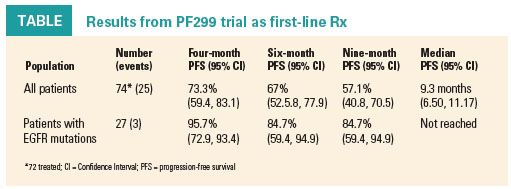Next gen EGFR targeting drug promising in NSCLC
Finding an effective treatment for all the complex iterations of cancer is akin to chasing an outlaw through a treacherous mountain range, in the estimation of Louis M. Weiner, MD, director of the Georgetown Lombardi Comprehensive Cancer Center in Washington, DC.
PF299804, an experimental pan-HER inhibitor, turned in promising PFS numbers in a couple of phase II trials. But overcoming anti-EGFR drug resistance will require targeting more than a single genetic mutation.
Finding an effective treatment for all the complex iterations of cancer is akin to chasing an outlaw through a treacherous mountain range, in the estimation of Louis M. Weiner, MD, director of the Georgetown Lombardi Comprehensive Cancer Center in Washington, DC.

"Imagine you are chasing an outlaw and you are trying to head him off at the pass," Dr Weiner said. "You put a drug at the pass, but you’re not thinking of the other ways that the outlaw might be able to get away. What we have to do in cancer is to try and figure out where the escape routes are and position drugs in those escape routes so that wherever the cancer turns, it is blocked."
One roadblock that has proven effective is the epidermal growth factor receptor (EGFR) inhibitor. In fact, two recent studies of a second-generation EGFR-targeting drug, PF299804 (PF299), demonstrated that the oral, once-daily, pan-HER inhibitor was as effective as, if not more effective than, its first-generation cousins for treating advanced EGFR-mutated non-small-cell lung cancer (NSCLC).
Principal investigators from both PF299 studies offered highlights from their research. Dr. Weiner spoke with Oncology News International about why these results are encouraging and why future drugs will need to cut off cancer’s escape at more than one pass.
Favoring EGFR mutations
The first study, led by Tony Mok, MD, tested the efficacy and safety of PF299 as a first-line treatment in patients with EGFR-mutated advanced NSCLC. Dr. Mok also led the phase III Iressa Pan-Asia Study (IPASS) which proved the validity of gefitinib (Iressa) as a first-line treatment in EGRF-mutated advanced NSCLC (N Engl J Med 361:947-937, 2009).
For the phase II PF299 trial, the patient population consisted of 74 patients, the majority of whom were Asian (46 of 74) and female (50 of 74), who were never smokers or former light smokers, and who had a mean age of 62 years. EGFR mutations were present in 41 patients. All were treatment-nave and had good ECOG performance status.

Initially, patients received a daily dose of 45 mg of PF299. However, that dose resulted in unacceptable toxicity, including grade 3 diarrhea in 15% of patients, skin rash in 15%, and stomatitis in 46%. When the dose was lowered to 30 mg, there was no grade 3 diarrhea or skin rash and the stomatitis rate was reduced to 3%, the authors reported.
The median progression-free survival (PFS) at nine months in all patients was 57%. Results were even more encouraging in patients with EGFR mutations, Dr. Mok noted (see Table). The median PFS in this group of patients had not been reached at the time the results were presented (ESMO 2010 abstract LBA18).
"These are preliminary data, but they show that PF299 is effective in patients who have advanced NSCLC, and that it clearly favors patients with EGFR mutations, so we are very encouraged," said Dr. Mok, a professor in the department of clinical oncology at the Chinese University of Hong Kong.
Objective response rate favors PF299
The second PF299 trial compared it with erlotinib (Tarceva) in advanced NSCLC patients who had failed up to two prior chemotherapy regimens in the first head-to-head study of the two agents.
The study randomized 94 patients to erlotinib (150 mg per day) and 94 patients to PF299 (45 mg per day). Median patient age was 61 years. Twenty percent of patients in the PF299 arm were ECOG performance status 2 compared with 3% of patients in the erlotinib arm.

FS was significantly improved in the group that received PF299, said lead investigator Suresh Ramalingam, MD, an associate professor, chief of thoracic oncology, and director of medical oncology at Emory University Winship Cancer Institute in Atlanta.
Median PFS was 8.3 weeks in the erlotinib arm and 12.4 weeks for patients treated with PF299 (hazard ratio [HR] = .7; P < .05). In a subset of patients with KRAS wild-type tumors, PFS was 8.4 weeks in the erlotinib arm vs 16.6 weeks in the PF299 arm (HR = .55; P < .05). The median duration of therapy with PF299 was 11.8 weeks compared with 8.3 weeks with erlotinib (ESMO 2010 abstract 365PD).
The objective response rate also favored PF299, coming in at 17% vs 6.4% with erlotinib (P = .04). The overall clinical benefit rate, defined as the response rate plus disease stabilization, was almost twice as high in PF299-treated patients, at 30% compared with 15% with erlotinib, Dr. Ramalingam reported. In addition, patients treated with PF299 experienced greater improvements in lung cancer symptoms and quality of life, he said.
Adverse events were consistent with the class effects of the EGFR inhibitors. Skin rash and diarrhea were common with both agents, but grade 3 diarrhea was more common in the
F299-treated patients. However, none had to discontinue the study due to diarrhea, Dr. Ramalingam said.
"We believe these data are supportive and will prompt a phase III trial that will aim to confirm the findings from this positive randomized phase II trial," he said.

Assessing EGFR resistance
"Both of these studies show that when you have an oncogene that is mutated, and that mutation is a major driver of the cancer, [the mutation] is more sensitive to being knocked down by effective tyrosine kinase inhibitors," said Dr. Weiner, who is also the chair of the oncology department at Georgetown University School of Medicine. "So this new pan-HER inhibitor may be particularly useful in patients with certain characteristics."
But what about the patients in whom EGFR inhibitors do not work? How can drug development move forward to help them? It will require looking beyond the single-gene takedown that dominates current treatment options.
"There aren’t going to be any simple answers," Dr. Weiner said. "Because we find a particular gene that is knocked down, we cannot infer that it is the Achilles heel of the cancer cell. Wouldn’t it be great if one gene turned out to be both necessary and sufficient to completely reverse drug resistance? We could say ‘Hooray, we found it!’ But it’s not going to work that way."
Dr. Weiner and his colleagues took a closer look at this phenomenon of EGFR inhibitor resistance. "About 10% of people who are treated with these inhibitors seem to have treatment benefit, but those benefits are typically short-lived, and resistance to the agents is nearly universal," he said. "We really don’t have a good understanding of who is going to benefit and who is not going to benefit from a particular treatment, and why. And if we don’t understand why, we can’t ever really make progress."
The group tested the idea that resistance to EGFR inhibitors is likely to be based on the cooperation of many different proteins working together. In addition, this resistance network would be very elastic and adaptable to multiple treatment protocols.
They defined all the genes and proteins in an EGFR-centered network and then determined which ones might activate escape signaling pathways when EGFR is targeted. Searching databases, they discovered 2,689 genes that encoded proteins that were linked to EGFR. To determine how these proteins function if EGFR is targeted, they chose 638 genes and targeted each gene with small interfering RNA (siRNA), which can knock down or silence the expression of the gene against which it is targeted.
"You can actually create a library of these siRNAs to knock down as many different genes as you think you’d like to try and go after. With an siRNA library, because you are knocking out the function of that gene temporarily, you can specifically assess whether that gene has a role in drug resistance or not," Dr. Weiner said.
They used a "synthetic-lethal-screening" technique to understand what happens to signaling proteins when an EGFR inhibitor is used. "In other words, we expose the cancer cells to the drug of interest, and then see whether knocking down any one of those genes in that 638-gene pool influences the resistance of those cells to that drug," he explained.
They did this for 16 different colorectal cancer cell lines with numerous EGFR inhibitors, and found 61 genes that were capable of sensitizing the tumor cells to drug therapy with EGFR antagonists (Science Signaling online, September 21, 2010).
Their results yielded some surprises. "We learned that using microarrays, which is the traditional way of looking at gene expression, did not help us understand which gene was going to be relevant for drug resistance and which gene was not. Furthermore, most of the genes that we identified were not mutated," he said.
In addition, they learned that knocking down the mutated KRAS did not have much influence on resistance to anti-EGFR drugs, suggesting that KRAS is a biomarker of drug response, but does not functionally contribute to drug resistance. "We speculated that KRAS mutations are important in establishing a malignant network outside of the EGFR network that drives the cancer," he said.
Dr. Weiner’s co-investigators for this research included co-first authors Igor Astsaturov, MD, PhD and Ilya Serebriiskii, PhD as well as co-senior author Erica Golemis, PhD, all from Philadelphia’s Fox Chase Cancer Center.
Source: Pfizer Oncology press briefing on PF299804 data.